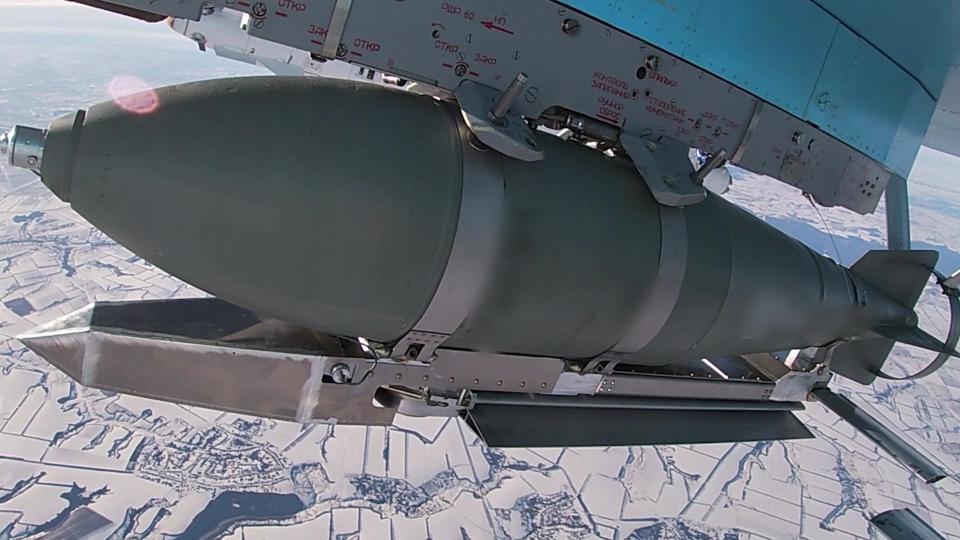-
Russia has increasingly relied on glide bombing to bomb Ukrainian frontline positions and cities.
-
A recent Ukrainian drone strike on a Russian air base suggests that Kiev is after the bombs.
-
According to the British Ministry of Defense, glide bomb kits appeared to have been destroyed in the attack on Saturday.
Ukraine’s massive weekend drone strike on a Russian air base deep behind enemy lines suggests Kiev may be trying to contain the threat of Moscow’s devastating glide bombs, according to new Western intelligence.
Russia has increasingly relied on glide bombing attacks to hit Ukrainian positions in recent months. These munitions are particularly difficult to intercept because of their short flight times, low radar signatures, and non-ballistic trajectories.
Glide bombs have flight control surfaces and are called standoff weapons, meaning Russian warplanes can fire them from a distance beyond the reach of Ukraine’s air defense systems. The only way to defeat the threat is to shoot down the planes before they fire the weapon or to hit them on the ground. Destroying the bombs before they get into the air is also an option.
As the Kyiv Independent reported, Ukrainian forces on Saturday fired dozens of attack drones at the Kushchevskaya airfield and two oil refineries in southwestern Russia, quite far from the front line. It was Kiev’s latest long-range attack targeting Moscow’s military and energy facilities.
The Kushchevskaya base is home to Russian Su-34 and Su-35 fighter jets, which are “used daily in attack missions against Ukrainian frontline positions, including heavy use of glide bombing,” Britain’s Defense Ministry wrote on Tuesday Intelligence update. The ministry said footage from a storage site at the airfield showed several glide bomb sets were destroyed in Saturday’s attack.
It was not immediately clear whether any of the planes were damaged or destroyed in the attack. Satellite images of the airfield shared by Brady Africk, an open source intelligence analyst at the American Enterprise Institute think tank, showed some damage to the facility.
Britain’s Defense Ministry said Russian fighters from Kushchevskaya and other similar bases “typically carry out 100 to 150 sorties per day, a significant percentage of those firing munitions along front lines as Russia attempts to force breakthroughs through sheer firepower.”
“Ukraine’s ability to disrupt Russian tactical air strikes, particularly the use of glide bombs, is critical to the broader defense of the frontlines,” the UK continued. “This successful attack will likely force a further dispersal of Russian fighter aircraft as well as a redeployment of air defense forces to close gaps.”
Glide bombs have been a headache for Kiev’s forces for much of the war, but Russia has significantly increased its attacks with the weapons in recent months. These weapons posed a particular problem earlier this year around the eastern Ukrainian city of Avdiivka, which Moscow captured after a bloody, months-long campaign.

Unlike traditional gravity bombs, which are dropped over a target, glide bombs can be launched miles behind the front line, limiting an aircraft’s exposure to enemy air defenses. The Russian Defense Ministry said in March that it had begun ramping up production of various types of munitions – including 6,600-pound munitions – that could be modified and converted into glide bombs.
Saturday’s attack on the Kushchevskaya air base is not the first time that Ukraine has attacked Russian air bases that are home to fighter-bombers capable of dropping glide bombs. In early April, Ukraine carried out a huge drone attack on the Morozovsk air base in Rostov, located hundreds of kilometers inside Russia.
While the extent of the damage was ultimately unclear, the attack appeared to underscore Ukraine’s desire to defeat the glide bomb threat before the plane could take off. Experts warn that Russian glide bombs pose a huge threat to Ukrainian armed forces.
Analysts at the Institute for the Study of War think tank said Saturday that Russian forces had “significantly transformed tactical air operations in Ukraine through the massive use of glide bombs, allowing fixed-wing aircraft to carry out attacks from further back more safely.” “
The analysts wrote in their assessment: “These glide bombing attacks will continue to play a crucial role in supporting Russian ground operations this summer, despite the likely improved air defense capabilities that Ukrainian forces can use as an additional Western air force against Russian aircraft.” Defense materiel is arriving. “
Read the original article on Business Insider
